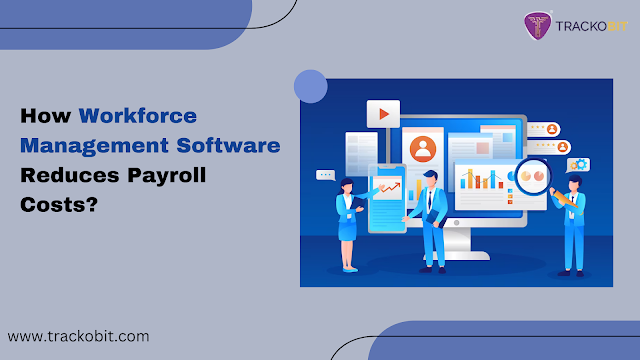How Workforce Management Software Reduces Payroll Costs?
Labor costs are one of the biggest expenses for businesses, be it a big conglomerate or even a fancy garden center. If it’s not tackled properly, it can quickly shoot through the roof.
Leveraging Field workforce management software could be the best deal as it automates labour schedules, optimise workload and work hours, and look into factors responsible for over or under staffing. Knowing these factors helps save significant labour costs by up to 10% (varying from industry to industry).
Let’s explore how automated workforce management software helps in reducing payroll costs by a significant percentage.
What is Workforce Management Software?
Field workforce management software streamlines employee scheduling, time tracking, and payroll processes for field executives. It enables accurate shift assignment, helps track attendance, manage leave requests, and forecast staffing needs.
When integrated with payroll and reporting software, workforce management solutions enhance efficiency, compliance, and resource optimization while improving employee engagement. There are uncanny benefits of workforce management software that help reduce business' significant costs mainly payroll-related costs in the following ways:
How the Best Workforce Management Software Helps in Reducing Payroll Costs?
Real-Time Workforce Tracking & Monitoring
Workforce management solution offers real-time monitoring features that help managers track attendance, punctuality, and compliance with work schedules. This helps organizations address potential attendance issues, and avoid risks of absenteeism, thus, reducing productivity costs.
Improved Absence and Leave Management
Workforce management software helps make the tasks of managing attendance and leave a breeze. It simplifies this process by digitising the process of submitting requests, approvals, and scheduling.
Down the line, the automation of this basic but important process helps lead to fewer errors and ease up the administration’s burden of manual compiling. Furthermore, the managers and admins are able to optimise staffing levels without relying on costly ad-hocs or temporary staff.
Real-time Analytics and Reporting
Workforce management system offers an analytics platform where managers can feed invaluable insights into it, like:
Workforce trends
Performance specific metric
Cost analytics and more
Organizations through the above integrated metrics can take data-driven decisions and further implement strategies that can help optimise labour costs. The above-fed data helps employers or organisations reveal certain patterns like — employees' overtime, low productivity areas, underutilized workforce, etc.
Better Employee Scheduling
For management, factors like employees' current availability, strengths & skillsets, labour laws, employee preferences, and compliance requirements are important to schedule shifts. Knowing these factors helps generate work schedules that minimise overtime and prevent understaffing. As a result, it helps achieve a better balance between workload and staffing level.
For organisations, where labour demand fluctuates as per changing season, having workforce management software is a must. The Best workforce management software works by providing data and insights to look through the gaps and maintain optimum schedules without overstaffing or paying high remuneration.
Reduced Overtime Expenses
When organizations are limited on staff and have heavy workloads, they require their limited staff to pull up socks for overtime. This becomes problematic as employee output drops, and more cases of absenteeism are likely during standard work hours. Plus, for businesses, the overtime rate is higher than the standard rate. A total lose-lose situation for businesses and their staff.
Automated workforce management software helps look into the work seasons, demand, and efficiency to schedule shifts optimally. It also lets employees easily swap shifts or maintain optimal time-off requests. This way businesses won’t have to invest in costly last-minute hires. On top of that, the workforce management systems software has a demand forecasting capability which helps with better employee scheduling.
Precise Demand Forecasting
The workforce management software has the ability to collect historical data in the form of current employee size, strength, availability, sales data, work schedules, and much more. Based on collected data, it helps forecast labour demand or any staffing requirement. Such information enables organisations to staff sufficient employees during peak hours and prevent overstaffing during slower periods.
Having a clear forecast brings several benefits to organisations and the workforce overall, mainly as:
When there is more stability around planning shifts, it helps reduce employees' stress and nurture their work-life balance.
Helps organisations to avoid indulging in costly overtime wages or filling in temporary staff.
All in all, workforce management reduces costs by offering precise demand forecasting based on shared trends & data. And all this further helps in reducing payroll costs.
Conclusion
Automated workforce management software is an emerging tool that helps control labour or payroll costs by carefully analysing, forecasting demand, optimising employee schedules, and managing absenteeism. It also helps control one of the most staggering labour costs caused by employee turnover.
Looks like, if businesses are serious about saving in some employment costs, opting for automated workforce management solutions offering seamless API integrations to connect software with reporting and business Intelligence tools is a must.
Related Blog:- Can Employee Retention Be Improved in Field Operations Teams?
Nurture Your Employees’ Productivity with Workforce Management Software
How To Improve Workforce-Planning Challenges With AI


.png)
.png)
Comments
Post a Comment